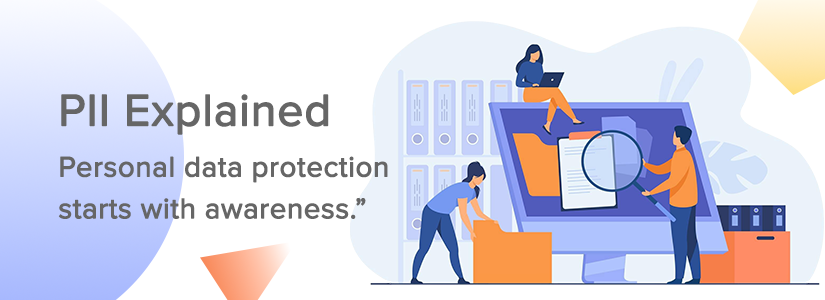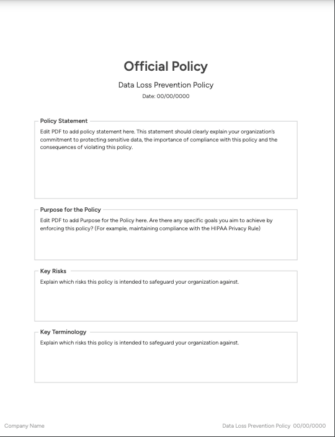What Is Personally Identifiable Information (PII): Everything You Need to Know

With technology woven into every part of our lives, protecting personal privacy has never been more important or challenging. One term that frequently arises in conversations about cybersecurity, compliance, and data ethics is PII, or Personally Identifiable Information.
To dive deeper, here’s what this article will cover:
- What PII is and why it matters in a hyper-connected world
- The difference between direct and indirect identifiers
- Why businesses and individuals must take PII seriously
- Key privacy laws and the consequences of non-compliance
What Is PII?
Personally Identifiable Information (PII) refers to any information that can be used to distinguish or trace an individual’s identity, either on its own or when combined with other personal or identifying data.
The National Institute of Standards and Technology (NIST) defines PII as: “any information about an individual maintained by an agency, including (1) any information that can be used to distinguish or trace an individual’s identity… and (2) any other information that is linked or linkable to an individual.”
This definition underscores the complexity of protecting PII in modern systems that consolidate data across platforms. While some pieces of PII are more sensitive than others, mishandling of even seemingly harmless information can have serious consequences.
Types of PII
To fully understand PII, it’s important to recognize the various forms it can take and how each type poses a different level of privacy risk. Generally, PII is divided into two main categories: direct identifiers and indirect identifiers. Understanding the distinction is essential for implementing effective data protection practices:
- Direct Identifiers: Pieces of data that can directly identify a person without needing additional information
- Indirect Identifiers: Pieces of information don’t identify someone on their own, but can do so when combined with other data:
Here’s a quick table comparing direct and indirect identifiers with examples:
Common PII Example:
Direct Identifiers |
Indirect Identifiers |
| Full name | Date of birth |
| Social Security Number (SSN) | Gender |
| Passport number | Zip code |
| Driver’s license number | IP address |
| Biometric data (fingerprints, facial scars) | Employment information |
| Personal phone number | Geographic location |
| Personal email addresses | Device or browser identifiers |
| Education history |
Why PII Matters in the Digital Age
Data Is Collected Everywhere. The average person’s digital footprint includes hundreds of data points quietly collected through everyday interactions.
Digital moves that contribute to your data trail, to name a few:
- Signing up for a newsletter
- Using GPS
- Shopping online
- Interacting with smart home devices
- Downloading a mobile app
- Accepting cookies on a website
- Using social media
- Etc.
This accumulation of data points forms a comprehensive digital profile that companies and advertisers utilize for various purposes.
These profiles may be used for:
- targeted advertising
- credit scoring
- Political campaign messaging
- personalized insurance rates
- health monitoring
- automated hiring decisions.
Over time, this level of profiling can lead to erosion of privacy, discrimination, algorithmic bias, and manipulation of choices, especially when individuals are unaware of how their data is being used. Many users don’t realize how much data they’re giving away—or how easily that data can be misused if not protected with the right safeguards.
Cybersecurity Threats Are on the Rise
As the volume of data stored and transmitted online increases, so does the risk of cyberattacks. Personally Identifiable Information (PII) is a prime target for malicious actors. In 2023 alone, there were over 3,200 publicly reported data breaches in the U.S., exposing more than 353 million sensitive records.
Once compromised, PII can fuel a range of malicious activities such as:
- Identity theft: Cybercriminals can use stolen PII—like Social Security numbers or full names—to impersonate individuals, open unauthorized accounts, or gain access to sensitive services.
- Financial fraud: With access to personal and financial details, attackers can make unauthorized transactions, apply for loans, or drain bank accounts.
- Sophisticated phishing schemes: Hackers often use PII to craft convincing phishing emails or messages that trick users into revealing even more sensitive information or downloading malware.
Breaches can affect millions of people and disrupt critical services. Victims may face financial losses, credit damage, and long-term identity recovery challenges.
PII in Business and Compliance
A Business Imperative
In 2024, the global average cost of a data breach rose to $4.88 million, the highest to date. This is a 10% jump from 2023. Alarmingly, one-third of breaches involved shadow data, highlighting the increasing difficulty of managing and securing scattered information.
Organizations have a legal, ethical, and business responsibility to protect customer, employee, and partner data. Breaches lead to fines as well as the loss of brand reputation and customer trust. Data protection isn’t just a task for the IT department—it’s a company-wide priority. Marketing, HR, legal, and customer service teams all play a role in protecting PII.
A Legal Requirement
Various data privacy laws around the world govern how PII must be collected, stored, and protected. Some of the most prominent regulations include:
- GDPR (General Data Protection Regulation) – Applies to EU residents and any business that collects their data.
- CCPA (California Consumer Privacy Act) – Gives California residents rights over their data.
- HIPAA (Health Insurance Portability and Accountability Act) – Governs health-related PII in the U.S.
- FERPA (Family Educational Rights and Privacy Act) – Protects student education records in the U.S.
Violating these laws can result in substantial penalties. For example, GDPR allows fines of up to €20 million or 4% of annual global turnover, whichever is higher.
Safeguarding PII is central to maintaining operational integrity and regulatory compliance. As data privacy regulations become stricter, businesses must stay vigilant in understanding and fulfilling their responsibilities. This means not only meeting legal obligations but also fostering a culture of data awareness across all teams. Doing so strengthens consumer trust and helps reduce the risk of costly breaches.
How Intradyn Can Help
Intradyn specializes in secure email archiving solutions that help businesses safeguard sensitive information, including Personally Identifiable Information (PII). By ensuring that email data is properly stored, encrypted, and easily retrievable, Intradyn minimizes the risk of data breaches and compliance violations. Furthermore, Intradyn’s solutions support regulatory requirements by providing detailed audit trails and advanced access controls. With Intradyn, organizations can confidently manage their data while protecting privacy and maintaining trust.
Key Takeaways:
- Personally Identifiable Information (PII) includes any data that can identify or trace an individual alone or when combined with other information.
- PII is categorized into direct identifiers (which identify individuals on their own) and indirect identifiers (which require additional data to identify someone).
- Every day, digital activities generate vast amounts of data points, creating detailed profiles that can be used for advertising, credit scoring, insurance, and more, raising privacy risks.
- Cyberattacks targeting PII are increasing, with data breaches leading to identity theft, financial fraud, and sophisticated phishing attacks.
- The global average cost of data breaches is rising, emphasizing the business imperative to protect PII beyond just IT departments—marketing, HR, legal, and customer service teams must be involved.
- Numerous global privacy laws regulate the collection, storage, and protection of PII, including GDPR, CCPA, HIPAA, and FERPA, with heavy penalties for non-compliance.
- Maintaining PII protection is vital for operational integrity and compliance; businesses must understand their responsibilities and foster a culture of data awareness to build trust and reduce risks.
FAQ
Why is PII important in today’s digital world?
Because everyday activities generate extensive digital footprints, PII is collected widely and used for things like advertising, credit scoring, and insurance. Without proper protection, this data can lead to privacy risks, discrimination, and misuse.
How do cybercriminals use stolen PII?
Stolen PII can be used for identity theft, financial fraud, opening unauthorized accounts, and launching phishing attacks to trick victims into revealing more sensitive information.
What are the consequences of data breaches involving PII?
Data breaches can cause financial losses, damage credit scores, disrupt services, harm brand reputation, and lead to costly legal penalties.
What legal regulations govern the protection of PII?
Key regulations include GDPR (EU), CCPA (California), HIPAA (health data in the U.S.), and FERPA (student education records in the U.S.). Violations can result in heavy fines and penalties.
Who is responsible for protecting PII in an organization?
Protecting PII is a company-wide responsibility involving IT, marketing, HR, legal, and customer service teams. Data protection is essential for compliance and maintaining customer trust.
How can organizations better safeguard PII?
By implementing strong security measures, educating employees, monitoring data usage, and using secure data management solutions like email archiving with encryption and audit trails.

